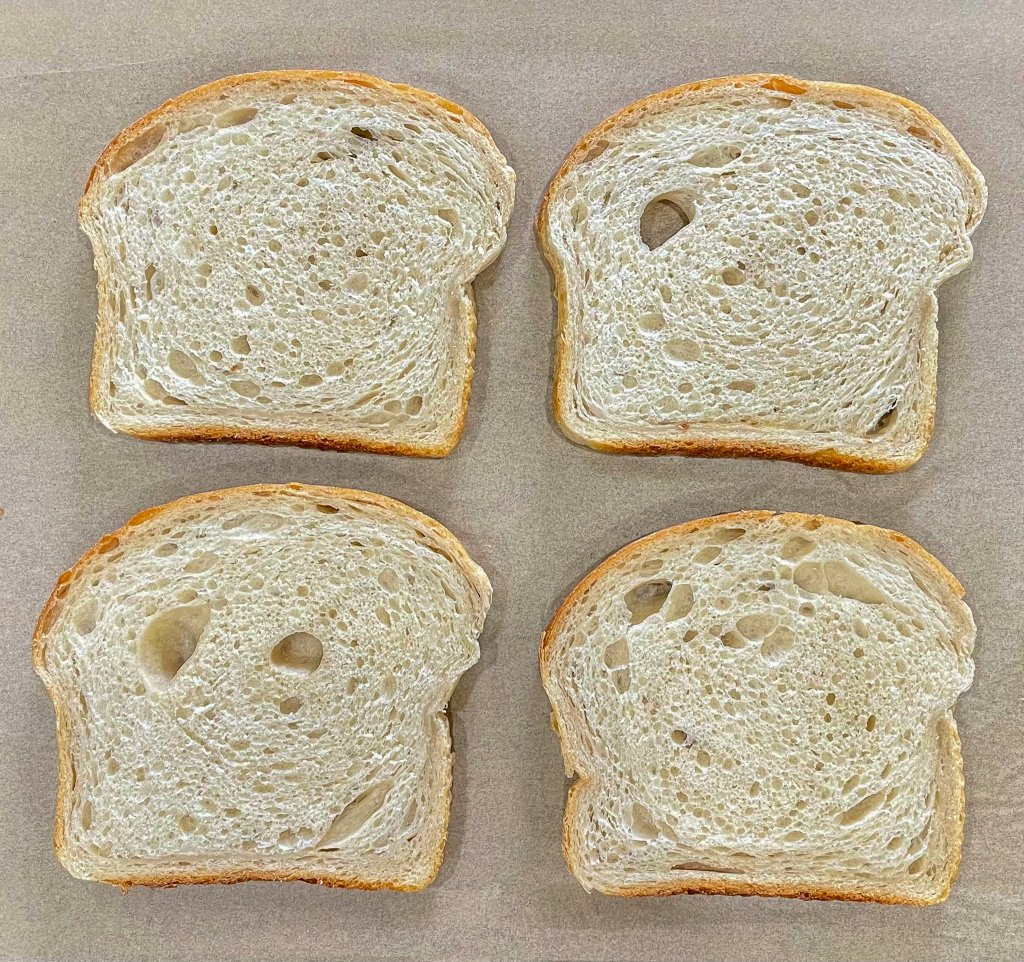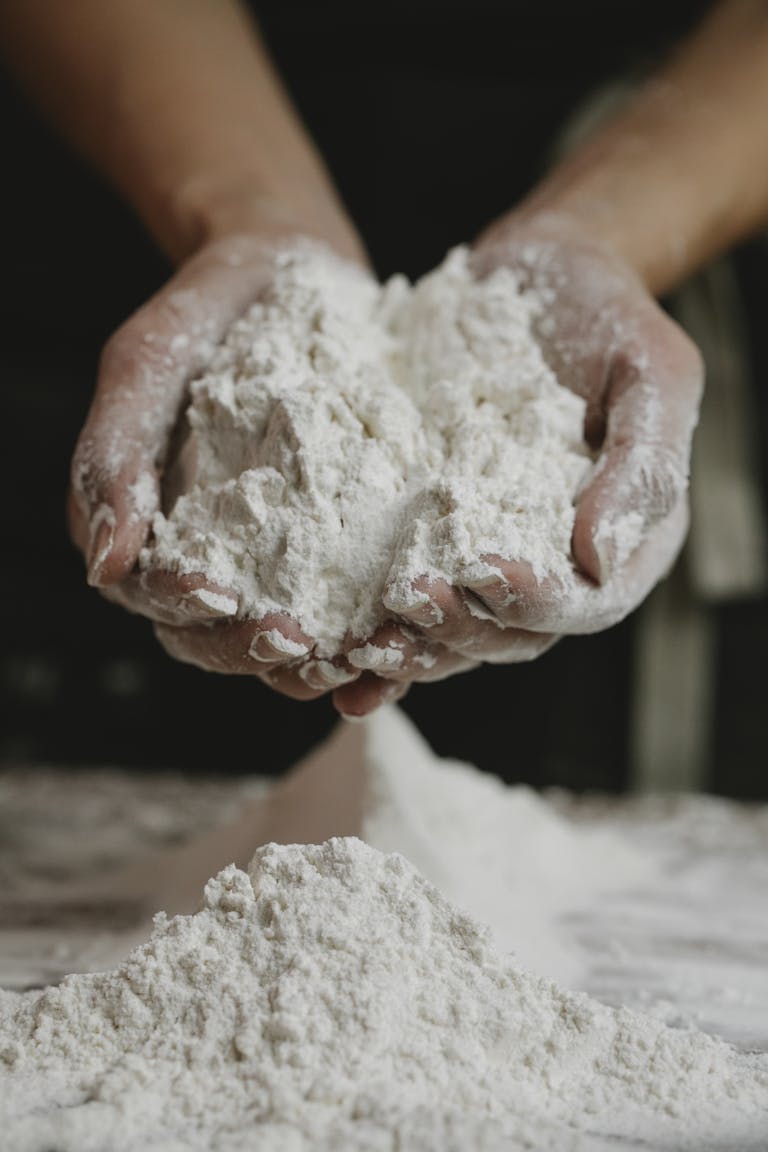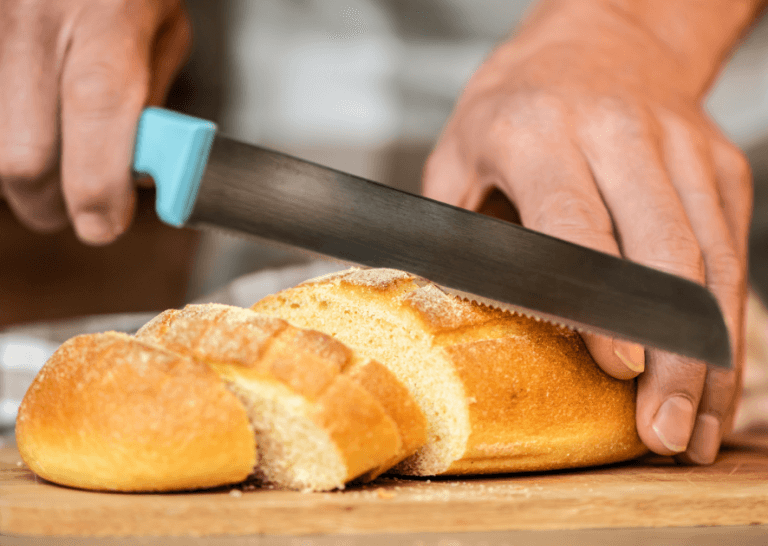How to Freeze Sourdough Bread Like an Expert (with 10 FAQs!)
There’s nothing quite like breaking into a loaf of freshly baked sourdough bread – that perfect crackling crust giving way to a chewy, tangy interior with those beautiful open holes that capture butter and jam in the most delightful way! But what happens when you’ve baked more than you can eat? Freezing sourdough bread is the answer to preserving that artisanal quality and extending the life of your homemade or bakery-bought loaves. In this guide, I’ll walk you through everything you need to know about how to freeze sourdough bread while maintaining its exceptional texture and flavor.
Disclaimer: As an Amazon Associate, I earn from qualifying purchases.
Why Freeze Sourdough Bread?
There’s nothing worse than watching a gorgeous loaf of sourdough go moldy before you can finish it. Been there, done that! After spending hours nurturing my sourdough starter (I call her Ivy Bubblin), mixing, folding, and waiting for that perfect rise, it’s heartbreaking to throw away even a single slice.
Freezing sourdough bread changed everything for me. Unlike those factory-made loaves from the grocery store, sourdough’s natural fermentation process actually creates a bread that freezes exceptionally well. The acids produced during fermentation help preserve the bread’s structure when frozen, which is pretty darn cool if you ask me.
I now do batch baking – usually 4-6 loaves at a time. This saves me so much time and energy! Plus, there’s something incredibly satisfying about opening your freezer to find a stash of artisanal bread ready to go whenever a craving hits.
Many people think freezing ruins sourdough’s texture, but that’s just not true if you do it right. I’ve served thawed sourdough to dinner guests who had no idea it wasn’t baked that day. Talk about a win!
When to Freeze: Timing Matters
Okay, so here’s something I learned – timing really matters when freezing sourdough bread. My first attempt involved freezing a week-old loaf that was already starting to stale. Bad move! The results were… less than stellar.
The optimal time to freeze sourdough is once it’s completely cooled, but still on the same day it was baked. The bread needs to be at room temperature throughout (no warm spots in the middle!), which usually takes about 2-3 hours after coming out of the oven.
I’ve found that store-bought sourdough follows slightly different rules. Since it often contains additional ingredients to extend shelf life, I try to freeze it within 1-2 days of purchase. But honestly, nothing beats the freezeability of a good homemade loaf without preservatives.
One thing that’s worked great for my baking schedule is planning ahead. I usually start my sourdough in the evening, mix the dough and ferment the next day, and bake it the following day. This rhythm ensures I always have the freshest possible bread going into the freezer.
Pre-Freezing Preparation
The first time I tried freezing sourdough, I was in such a rush that I wrapped up a still-warm loaf. Big mistake! The residual heat created condensation inside the wrapping, and I ended up with a soggy loaf when I thawed it. Lesson learned!
Proper cooling is non-negotiable. I now place my baked loaves on a wire rack and force myself to wait until they’re completely cool to the touch before even thinking about freezing them. This patience pays off big time in the final quality.

One of the biggest decisions you’ll face is whether to freeze whole loaves or pre-slice them. After much experimentation, I’ve landed on a hybrid approach. For everyday use, I slice most loaves before freezing – it’s so convenient to grab just what I need. But I always keep one or two whole loaves in the freezer for when I want to impress guests with that perfect “freshly baked” experience.
A handy tip I’ve picked up is to score or mark my different varieties before freezing. I went through a phase where I was baking multiple types of sourdough (classic, whole wheat, brioche) and couldn’t tell them apart once wrapped. Now I make distinctive marks on the wrapping or use different colored freezer tape. No more mystery bread!
Wrapping and Packaging Methods
Let’s talk about wrapping – this is where I used to REALLY mess up. I started with just tossing loaves into plastic bags, and wow, was that a rookie mistake! Freezer burn city, population: my poor sourdough.
After much trial and error, I’ve become a firm believer in the double-wrap method for maximum freshness. First, I wrap the completely cooled bread tightly in plastic wrap (getting out as much air as possible), then I add a second layer of aluminum foil. Finally, I put them in bread bags with a plastic liner to further protect them. This triple protection keeps freezer burn at bay and locks in that amazing sourdough flavor.
Proper Freezing Techniques
When it comes to freezer temperature, I learned this one through some serious trial and error. My old freezer wasn’t maintaining a consistent temp, and my sourdough was suffering for it! The ideal freezer temperature for sourdough bread is 0°F (-18°C) or below. I actually bought a cheap freezer thermometer after noticing inconsistent results, and wow – it made such a difference to monitor this!
Flash freezing is another method when it comes to storing sliced sourdough bread. The first time I threw sliced bread in the freezer, all the pieces froze together in one solid chunk. Not helpful when you just want a single slice for toast! I haven’t tried this method myself (I have hungry kids that eat an entire loaf in 2-3 days!). But I’ve heard of people placing their sliced bread on a baking sheet, making sure the slices aren’t touching, and freezing them for about 2 hours before transferring to a storage container. This way, they can grab just one or two slices whenever they need them without having to thaw the entire loaf.
Believe it or not, where you position your bread in the freezer matters a ton. I used to just cram my loaves wherever they would fit, but I noticed inconsistent results. The bread stored near the door (where temperature fluctuates every time you open it) suffered the most. Now I place my sourdough toward the back and center of the freezer where the temperature stays most consistent.
One tip that’s saved me from freezer burn heartbreak is placing a paper towel in with sliced bread. The paper towel absorbs excess moisture that might otherwise turn into ice crystals on your bread. Just don’t forget to remove it before thawing! I also try to squeeze out as much air as possible before sealing my packages – air is the enemy when it comes to preserving that perfect sourdough texture.
How Long Can You Freeze Sourdough Bread?
I used to think frozen bread would last basically forever, but my taste buds quickly educated me otherwise! Through lots of (sometimes disappointing) experimentation, I’ve found that sourdough bread maintains optimal quality in the freezer for about 1-3 months. After that, it’s still safe to eat, but the quality definitely starts to decline.
The first month is prime time – the bread tastes almost identical to fresh when properly thawed and refreshed. By month two, there’s a slight difference, but it’s still excellent. After three months, you might notice more textural changes and a slight decrease in that complex sourdough flavor. I once found a loaf that had been hiding in my freezer for 6 months, and while it was edible after refreshing, it definitely wasn’t the same experience.
Wondering if your frozen sourdough is still good? Check for excessive ice crystals or any signs of freezer burn (whitish spots or dry patches). If the bread has an off smell when thawed or shows any signs of mold (which is rare but possible if it wasn’t fully frozen), it’s time to say goodbye.
I’ve noticed that whole loaves generally last longer in the freezer than sliced bread. Those cut edges on sliced bread are more vulnerable to moisture loss and freezer burn. My whole loaves consistently maintain quality for closer to the 3-month mark, while sliced bread starts showing its age closer to 4-6 weeks.

Thawing Methods for Best Results
I’ve tried every thawing method under the sun, and let me tell you, not all methods are created equal! Room temperature thawing is my go-to for whole loaves. I just place the wrapped loaf on a cutting board and let it thaw for 3-5 hours (depending on size). The refrigerator method (overnight thawing) works well too, but sometimes leaves the bread a touch drier.
When I’m really in a pinch, I’ve used the oven method – placing the frozen loaf directly in a 325°F oven for about 20-30 minutes. This works surprisingly well for whole loaves! Not so much for sliced bread though, which is better thawed at room temperature or toasted directly from frozen.
The crust is the crown jewel of a good sourdough, and maintaining its integrity through freezing and thawing took me some practice. I’ve found that thawing a whole loaf in its wrapping at room temperature, then unwrapping and heating it in a 350°F oven for 5-10 minutes gives me that perfect crispy crust again. It’s almost identical to fresh-baked!
In a hurry? Been there! For those mornings when I need bread ASAP, I’ve found that sliced frozen sourdough can go straight into the toaster. It takes a slightly lower setting than fresh bread to prevent burning (since it needs to thaw and toast).
Different varieties of sourdough really do need different thawing approaches. My enriched sourdough (with avocado oil or honey) thaws beautifully at room temperature with no additional help. However, my super crusty country loaves benefit from a spritz of water before going into a hot oven for that final crisp-up after thawing.
Refreshing and Reviving Frozen Sourdough
The biggest game-changer in my frozen sourdough journey was learning proper refreshing techniques. My favorite method is to lightly spritz the thawed loaf with water (using a clean spray bottle), then pop it into a preheated 350°F oven for about 5-10 minutes. The water helps recreate that steamy environment that gave the bread its crackling crust in the first place.
For sliced bread, the toaster is your best friend! I find that frozen slices actually toast up more evenly sometimes than fresh bread. The key is to use a slightly lower setting than usual, as mentioned earlier. If I’m making sandwiches, I’ll thaw the slices at room temperature first, then very lightly toast them to refresh the texture without making them too crunchy.
Want that “just baked” quality back? Here’s my secret weapon: after thawing a whole loaf, I brush the crust very lightly with water (or a mixture of water and a tiny bit of apple cider vinegar), then bake at 375°F for exactly 7 minutes. The acid in the vinegar seems to help revive that slight sourdough tang in the crust, and my family can rarely tell it was frozen!
Sometimes thawed sourdough can get a bit tough or chewy – a problem I experienced frequently when I first started freezing bread. I discovered that placing the thawed loaf in a paper bag for an hour helps redistribute the moisture more evenly. For extra-dry bread, place a small dish of water in the oven alongside the bread during reheating to add moisture to the environment.
Creative Uses for Thawed Sourdough
Let’s be real – sometimes your thawed sourdough isn’t quite perfect for sandwiches or plain eating. That’s when I get creative! Slightly older thawed sourdough makes THE BEST sourdough bread pudding you’ve ever had. The slightly firmer texture holds up beautifully to the egg mixture, and the tangy flavor adds a wonderful dimension against the sweetness. My weekend specialty is sourdough bread pudding with cinnamon and a touch of vanilla – my kids go crazy for it!

When my frozen sourdough is past its prime for regular use, it transforms into amazing homemade breadcrumbs or croutons. I cube the bread, toss with olive oil, garlic, and herbs, then bake until crispy for croutons that blow away anything store-bought. For breadcrumbs, I pulse the bread cubes in a food processor and bake at 325°F for about 20-25 minutes.
With these techniques, I’ve managed to eliminate almost all bread waste in my house while enjoying incredible sourdough whenever I want it. The convenience of having ready-to-go artisanal bread has made my meal prep so much easier, and my wallet is happier too! What methods have you tried for preserving your sourdough? I’d love to hear your experiences in the comments below!
FAQs: How to Freeze Sourdough Bread
1. Can sourdough bread be frozen successfully?
Yes, sourdough bread freezes exceptionally well due to its natural fermentation process. When properly wrapped and stored, frozen sourdough can maintain its texture and flavor for up to 3 months, making it an excellent way to preserve homemade or bakery-bought loaves.
2. When is the best time to freeze sourdough bread?
The optimal time to freeze sourdough bread is after it has completely cooled, but on the same day it was baked. Letting it cool for 2-3 hours after baking ensures no residual heat will create condensation in the wrapping, which can lead to sogginess when thawed.
3. Should I slice my sourdough before freezing it?
This depends on how you plan to use it. Pre-slicing before freezing allows you to take out only what you need, which is ideal for daily toast or sandwiches. However, keeping loaves whole generally preserves quality better and is recommended if you want to serve the entire loaf at once, as it better maintains crust integrity.
4. What’s the best way to wrap sourdough bread for freezing?
The most effective method is double-wrapping: first tightly wrap the completely cooled bread in plastic wrap to remove as much air as possible, then add a second layer of aluminum foil or place in a freezer bag. This dual protection prevents freezer burn and preserves flavor. For an eco-friendly alternative, use parchment paper followed by a reusable silicone freezer bag.
5. How long can sourdough bread be stored in the freezer?
Sourdough bread maintains optimal quality in the freezer for 1-3 months. While it remains safe to eat beyond this period, the quality gradually declines. Whole loaves typically maintain their quality longer (closer to 3 months) than sliced bread (best used within 4-6 weeks).
6. What’s the best method for thawing frozen sourdough bread?
For whole loaves, thaw at room temperature for 3-5 hours while still wrapped. For sliced bread, either thaw slices at room temperature for 30 minutes or toast directly from frozen. Avoid microwaving as it can make the bread tough and rubbery.
7. How can I restore the crust of thawed sourdough bread?
To revive the crust, lightly spritz the thawed loaf with water and heat in a preheated 350°F (175°C) oven for 5-10 minutes. This recreates the steamy environment that originally formed the crust during baking and restores its crackling texture.
8. Can I refreeze sourdough bread that has been thawed?
It’s not recommended to refreeze sourdough bread that has been completely thawed, as it significantly impacts texture and flavor. Instead, only thaw what you plan to use and keep the rest frozen. If you must refreeze, expect some quality loss in the bread’s texture.
9. What can I do with thawed sourdough bread that’s past its prime?
Slightly stale thawed sourdough is perfect for French toast, bread pudding, croutons, breadcrumbs, stuffing, or panzanella salad. These recipes actually benefit from bread that’s a bit dried out, as it absorbs flavors better without becoming soggy.
10. How can I tell if my frozen sourdough bread has gone bad?
Check for excessive ice crystals inside the packaging, noticeable freezer burn (dry, discolored patches), or an off smell when thawed. While rare, if you see any mold after thawing, the bread should be discarded. This typically only happens if the bread wasn’t frozen completely or was contaminated before freezing.
Conclusion
Freezing sourdough bread doesn’t have to be complicated, and with the right techniques, you can enjoy that artisanal quality weeks or even months after baking. By following the steps we’ve outlined – from proper cooling and wrapping to thoughtful thawing and refreshing – you’ll minimize waste and maximize enjoyment of your sourdough creations. Remember that even imperfectly frozen and thawed sourdough can find new life in creative recipes! Have you tried freezing your sourdough bread yet? Give these methods a try and enjoy the convenience of having delicious, high-quality sourdough bread available whenever you crave it!







